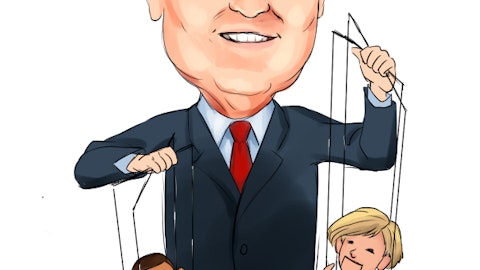John Donahoe: Yes, let me start. By talking about pricing power, one of the biggest benefits to a strong brand, an innovative brand, a brand that’s continuing to bring freshness and newness to the consumer, is pricing power. And over the last couple years, given our brand strength, we’ve been able to implement strategic pricing in order to be able to offset, some of the headwinds that we’ve been facing. But as we look forward, we believe that more newness, more freshness, products that are more connected to stories that are relevant to consumers, should give us the ability on a structural basis, to continue to expand our profitability. And the point, I was trying to make in response to Matt’s question is that when the brand is strong, the biggest driver of growth and margin expansion is strong consumer demand for the products we have.
And high levels of full price realization. And that ultimately is the fundamental as we carry forward. In the near term, one of the headwinds that we’re going to see is that not surprisingly, our digital business carries a higher mix of the biggest franchises that consumers love. And so, as we manage the supply of our larger franchises, we do expect that there will be a near term channel mix headwind, from transitioning our product portfolio. But we view that as being a near term factor, because ultimately for NIKE to grow at the rates that we aspire to grow to, we have to grow units across the marketplace. We have to go grow units in NIKE Direct, through digital in our stores, and we’ve got to grow units through our partners. And so that is where our focus is, dimensionalized through sport, our fields of play, the way we’ve always segmented the marketplace to grow.
So that we can work and serve the consumer, where the consumer is at. As far as operating profitability long-term, we continue to believe that we can expand gross margins by running our operating model and also driving value out of some of the things that we’ve talked about in the past, like product cost initiatives to lower our input costs. We’re actually already starting to see some benefits on that, in the back half of this year, continuing to drive supply chain efficiency. And then, as I mentioned, the way that we’re thinking about managing our SG&A, shifting more of our resources to be consumer facing, we’re focused on building an operating model that’s got greater speed and drives greater productivity as we grow. And we think that will also be a source of long-term margin expansion for the company.
Operator: Our next question will come from the line of Michael Binetti with Evercore ISI. Please go ahead.
Michael Binetti: Hi guys, thanks for all the detail and diagnosis about – a lot of the moving parts in the business here today. Very helpful. I guess as we look at the second quarter in a row, I guess wholesale in China has grown a lot faster than DTC. Obviously, that’s a very important market for you, a lot of important things for us to think about in that market. Can you help us a little color in the different trends in that market that you see? And then, I guess as we think about how you’ll manage these franchises into next year, we’ve also heard some good growth rates in some parts of the wholesale channel, for the first half of your fiscal year. So, I’m assuming we’ll see more of that franchise management on the DTC side.
And if so, considering that’s an important channel for the rest of the P&L, I’m assuming we can orient ourselves around gross margin pressure, in the start of next year as you work your way through that, before we see the influence of returning to growth down the P&L?
John Donahoe: Yes, Matt, why don’t I take the first part of that, you take the second. So, Michael, on China, interestingly, Angela Dong and her team and all of our top partners, were here for the last week. As you know, we have 6,000 model brand doors. They were here for innovation. And a couple of things are clear. Sport is strong in China and NIKE’s strong in China. Our growth in Q3 was 6%, which was in line with our plan. And we’re gaining share. We’re gaining share certainly against the global brands, and we’re gaining share against the local brands. So, NIKE’s brand is strong in its back. With regard to channel mix in your specific question, part of what’s driving that is the consumers back on the street. And so, I would say that the physical retail channel in China is stronger than digital.
And then within digital, Tmall, which was historically the biggest digital driver, is experiencing less growth. We’re still the number one sports brand on Tmall. And social commerce, Douyin is growing. And we’re not yet on Douyin. We’re just getting on Douyin. And so, you’ll see us expanding our growth into social commerce, which is the growing digital channel in China. But I can tell you, Matt and I had a chance and Craig Williams and others to meet with our partners from China. They came away seeing our innovation pipeline that I’ve been talking about, Matt and I have been talking about on this call, what we’ve got in store coming. And they, it was the first time they’d been on our campus in four years since COVID. And they came away excited, leaning in.
And so, we are very optimistic about the future in China. And we will grow across multi-channels to grow the market. It’s probably the area of the world we do that the best.
Matthew Friend: Yes. And to John’s point, not only do we have 6,000 stores, but China is a monobrand market. And so, whether it’s owned or partnered, it’s a monobrand market, which gives us the ability to have the best expression in front of the consumers, to be able to direct the assortment, so that as we bring newness and innovation and new stories, we partner with our partners. And the last thing I was going to say, Michael, is just the penetration of NIKE Direct in China is lower than what it is across our other geographies. In terms of your question about where we’ll see the franchise management, yes, you’re right. It will be more in NIKE Direct. And primarily because we continue to see a heavy level of promotional activity happening across digital, across all of our geographies.
And while we continue to see, as we’ve supplied our largest franchises to our wholesale partners, we’re actually seeing incredibly strong weekly sell-through on these franchises. We’re seeing high levels, high above our targets of full price realization. And so, our franchises are healthy. In fact, we could sell more of these products if we wanted to. But we don’t think that’s the right thing to do, from a brand point of view. And we know that we manage these franchises for long-term health. And so, we’re focused on scaling the newness and creating the consumer space, for us to tell stories about new things that, we’re bringing to drive energy. And that’s where our focus is. And so, that’s ultimately where our teams are spending their time.
And that’s what’s influencing the near-term transition that I highlighted a little bit earlier. As far as the margin question goes, what I’ll say is that we’re going to grow revenue and earnings next year. And we expect to drive operating margin expansion, excluding the impact of the restructuring charge. And that’s going to come through gross margin expansion first. And then, continuing to be disciplined in the way we manage SG&A in order, to be able to drive more productive growth.
Operator: Our next question will come from the line of Alex Straton with Morgan Stanley. Please go ahead.
Alex Straton: Perfect. Thanks for taking the question. Just a couple from me. On the front half ’25 revenue guidance down those single-digits, can you give us any color on how you’re thinking about it by geography or channel? And then, just bigger picture on this kind of wholesale reentering, are you having any trouble kind of rebuilding the muscle there, facing any difficulty as you reenter? Has NIKE’s criteria changed at all in terms of how you think about the right partners or distribution going forward? Thanks a lot.
Matthew Friend: Okay. John, why don’t I take the first part and then I’ll start the second one
John Donahoe: Okay.
Matthew Friend: If you want to jump in on that and go for it. So, Alex, I think the only thing I would say at this point, is the way that we’re thinking about the geography splits, is we’re not assuming that economic conditions in the international markets in particular get better. It assumes a status quo, relative to where we are today. And next quarter, I’ll provide more tangible insights into not only the first half, but our full year growth over fiscal ’25. On the wholesale side, what I would say is that I think the biggest thing to take away, is that we don’t like the way our brand is showing up in wholesale. And we own that. And we need to focus, on elevating the experience for consumers, when they come into interaction with our brand.
If you segment our marketplace by dimension and by, where we sell our units, our seasonal units on a full price basis. Our wholesale partners represent three quarters of the market, from a unit perspective. And so, the importance of being able to elevate, and to position our brand correctly and to tell stories about the products that, we’re bringing to market in that environment, is an absolutely critical way not only, to help consumers fall in love with the products we have, but to also give consumers that tangible ability, to come into real life connection with the NIKE brand. And so, what we’re focused on, beginning with the DN, is we’re going to see and you’ll feel the DN launch in 4,000 doors initially across the marketplace. And then when we look at the way we’re going to scale that innovation over the next several seasons through product journeys with different partners, telling different stories in different parts of the marketplace, we continue to.
We’re very excited about the impact that that could have on the market. And we know that it’s what we need to do. And so, the investments will be in things like seasonal marketing campaigns, elevating the presentation of our product, investing in the breadth and depth of the assortment, including color, so the consumer gets more choice off of the products that we care about the most, in order to be able to create that kind of impact across the market. We think we’ve got the right partners, but our strategy and our approach to the marketplace is constantly evolving, based on where the consumer is, based on where the consumer is shopping, and who’s connecting most with the consumers. So, apart from some of the areas that we’ve been talking about where we need to create new distribution, because we see growth opportunities that don’t line up with our current partners.
Our focus is on our current partners right now and elevating the experience of our brand with them.





